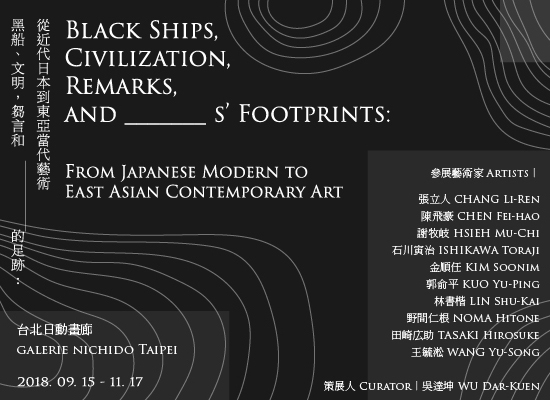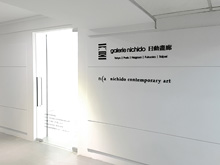Exhibitions
Black Ships, Civilization, Remarks, and ______s’ Footprints: From Japanese Modern to East Asian Contemporary Art


Download press release:
Black Ships, Civilization, Remarks, and ______s’ Footprints_Press Release.pdf
Exhibiting Artist|
CHANG Li-Ren, CHEN Fei-hao, HSIEH Mu-Chi, ISHIKAWA Toraji, KIM Soonim, KUO Yu-Ping, LIN Shu-Kai, NOMA Hitone, TASAKI Hirosuke, WANG Yu-Song
Curator|WU Dar-Kuen
Dates|2018. 09. 15 - 2018. 11. 17
Opening Reception|2018. 09. 15 15:00
Venue|台北日動畫廊 galerie nichido Taipei
galerie nichido Taipei is pleased to present Black Ships, Civilization, Remarks, and ______s ’ Footprints: From Japanese Modern to East Asian Contemporary Art curated by WU Dar-Kuen. The reception will start from 3pm. Since 2016, galerie nichido Taipei has been inviting curators in Taiwan every year to organize a show that combines modern and contemporary art. We endeavor to open up a more creative and in depth dialogue by joining different art works in time and space. Past editions include e Blue Bird in the Labyrinth: A Walk from Japanese Modern Art to Asian Contemporary Art Scene, curated by TAKAMORI Nobuo (2016), and Air Surprise: An Aerial View of Heterogeneous Landscapes in Modern and Contemporary Taiwan and Japan , curated by GONG Jow-Jiun (2017). We are honored to invite WU Dar-Kuen to curate this year’s edition entitled Black Ships, Civilization, Remarks, and ______s’ Footprints: From Japanese Modern to East Asian Contemporary Art. Starting from key words of East Asia in its modern era, the exhibition tends to invite viewers to imagine the multiple trajectories of the region by showing how contemporary artworks reflect, explore, and re interpret specific times in history. The curator will be present along with participating artists to tour the show. We sincerely invite all guests to join.
---
Black Ships, Civilization, Remarks, and ______s’ Footprints: From Japanese Modern to East Asian Contemporary Art
Text/ Wu Dar-Kuen
Black Ships
In the mid 19th century, the “Perry Expedition” opened a gateway to the Tokugawa Shogunate in Japan. Foreign trade brought new technology and further introduced industrialization in the country. The gigantic wheel of Meiji Restoration drove the revolutionary change in East Asia and influenced the political balance among nearby regions. In order to serve the empire and its colonialism, several anthropologists acted as explorers of the new world, conducting field works in Taiwan, Korea, venturing even as far as Manchuria. Their research not only supported the expansion of the Japanese Empire at that time, but it also drew an important path for the present to understand past societies. With nearly hundred years of research under the belief of progressive theories, East Asia has long seen modernization and economic development as the main doctrines worthy of consideration. However, looking back at this modern progressivism, what can we say that we have actually obtained and sacrificed? Is the majority satisfied with such progressive values? This exhibition starts from these concepts and tries to address the cultural differences and ideas of the East Asian multitude by exhibiting modern and contemporary artworks from Taiwan, Japan, and Korea through a cross-historical framework.
Civilization
If progressivism has brought about collective anxiety and self-negation in this century in East Asia, what contemporary creators are starting to show nowadays is a sense of confidence when interacting with the past. These artists attempt to take history, nature, and life as their guidance so as to steer a clear path for their own creation Chang Li-Ren uses animated images to challenge the limits of a one-man production. As the main character in Battle City tries to fight against the entire civilization and the whole world, contemporary media and powerful nations, the various doctrinal beliefs, too, subsequently become the subjects of criticism and satire. In Lin Shu-Kai’s works, past, present, and future of cities are assembled into totem-like codes, expressing the numerous personal, collective, and physical experiences achieved through civilization and within cosmopolitan structures. Korean artist Kim Soonim is skillful in using her works to reflect on nature and the process of modern civilization through a dialectical approach. She incorporates methods that remind of anthropological fieldworks so as to deduct the objects and things she has encountered in every present.
Remarks
The entire work of Homely Words to Aid Governance mostly discusses social progressivism in a wider sense. It includes topics from designing and planning process of politics, to building the mentality of the common people. First translated and introduced to East Asia in the 19th century, this textbook was made into a new work Autonomy by Kuo Yu-Ping. Using her own blood to transcribe the textbook, the artist became herself an archive through a performative act, artfully responding to the national doctrine and fighting against the disciplined force exercised through political bodies. Chen Fei-Hao takes the forgotten “Inari Shrines” in Taipei as his main theme and uses memory as a research subject to discuss the disparity between history and present in terms of social circumstances. He presents series of interviews with an imagery work titled The Past and Present of Taipei Inari Shrines. This explorative archival project shows simultaneously the intimate and distant bond between Taiwan and Japan. It manifests a civil imagery that goes beyond the inheritance of history, demonstrating the idea that what is being most cherished and deemed as essential is eventually the most crucial value.
_______s’ Footprints
The footprints of many Japanese anthropologists, such as Kanori Ino, Ryuzo Torii, Ushinosuke Mori, are spread all over the mountains and plains of Taiwan. Their on-site surveys and detailed researches gradually revealed the multicultural society of Taiwanese aborigines and Pingpu peoples. Ryuzo Torii has even showed his public dissent in several occasions to Japan’s militarism and its invasion of Asia. His humanitarianism is highly respected and honored both in the past and in the present. If these anthropologists had handed down documents and literary reports, then what Toraji Ishikawa left over after his fieldwork travels was the many unique scenery paintings of Taiwan. Artists such as Hirosuke Tasaki and Hitone Noma who grew up in the early 19th century also built their own creative context under similar social milieu by painting landscapes and historical scenes. Undeniably, Japan has played the mediating role in introducing Western painting techniques in East Asia. Based on the works of these early painters, artist Hsieh Mu-Chi further contemplates on how scenery painting has been formed and constructed in Taiwan by tracing its history way back to the first generation of local painters active in the beginning of 19th century. Hsieh sees scenery painting as a medium that generates a mutual relation between the artist and the context of early generations. He uses past images to induce and recreate iconic styles, making them a part of himself. In his works, scenery painting and painting are no longer what they simply seem to be. Tearing layers of personal memory and historical coatings, Wang Yu-Song’s paintings are composed of a special natural mineral powder applied repeatedly on the canvas, creating various layers through the covering and dying process. This scrutinizing process through specific techniques helps to connect scattered memories. The condensed black, the white bits, everything is depicted in a personal fashion, drawing lines of civilization, desire, memory, while the different scenery paintings hide or waver between time and space.
A Brief Summary
From the context of Japanese modern art hundred years before East Asia contemporary art, the missing footprints of ______ await the later generations as patterns to be followed at any time. In the future, there may be more artists riding on the shoulders of these early figures to interact with each other, interpreting their own creation with stronger confidence and openness, and leaving various artistic landscapes that can be remembered through all generations.
Gallery








